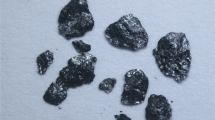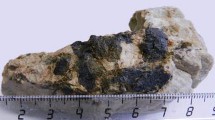Abstract
A new mineral ferricoronadite with the simplified formula Pb(Mn6 4+Fe2 3+)O16 was discovered in the orogenetic zone related to the “Mixed Series” metamorphic complex near the Nežilovo village, Pelagonian massif, Republic of Macedonia. Associated minerals are franklinite, gahnite, hetaerolite, roméite, almeidaite, Mn-analogue of plumboferrite, zincohögbomite analogue with Fe3+ > Al, zincochromite, Zn-bearing talc, Zn-bearing muscovite, baryte, quartz and zircon. Ferricoronadite is a late hydrothermal mineral forming veinlets up to 8 mm thick in granular aggregate predominantly composed by zinc-dominant spinels. The new mineral is opaque, black, with brownish black streak. The luster is strong submetallic to metallic. The micro-indentation hardness is 819 kg/mm2. Distinct cleavage is observed on (100). Ferricoronadite is brittle, with uneven fracture. The density calculated from the empirical formula is 5.538 g/cm3. In reflected light, ferricoronadite is light gray. The reflectance values [R max/R min, % (λ, nm)] are: 28.7/27.8 (470), 27.6/26.6 (546), 27.2/26.1 (589), 26.5/25.5 (650). The IR spectrum shows the absence of H2O and OH groups. According to the Mössbauer spectrum, all iron is trivalent. The Mn K-edge XANES spectroscopy shows that Mn is predominantly tetravalent, with subordinate Mn3+. The chemical composition is (wt%; electron microprobe, Mn apportioned between MnO2 and Mn2O3 based on the charge-balance requirement): BaO 5.16, PbO 24.50, ZnO 0.33, Al2O3 0.50, Mn2O3 9.90, Fe2O3 11.45, TiO2 4.19, MnO2 44.81, total 100.84. The empirical formula based on 8 cations Mn + Fe + Ti + Al + Zn pfu is Pb1.03Ba0.32(Mn 4+4.85 Fe 3+1.35 Mn 3+1.18 Ti0.49Al0.09Zn0.04)Σ8.00O16. The crystal structure was determined using single-crystal X-ray diffraction data. The new mineral is tetragonal, space group I4/m, a = 9.9043(7), c = 2.8986(9) Å, V = 284.34(9) Å3, Z = 1. In ferricoronadite, double chains of edge-sharing (Mn, Fe, Ti)-centered octahedra are connected via common vertices to form a pseudo-framework with tunnels containing large cations Pb and Ba. The strongest lines of the powder X-ray diffraction pattern [d, Å (I, %) (hkl)] are: 3.497 (33) (220), 3.128 (100) (−130, 130), 2.424 (27) (−121, 121), 2.214 (23) (240, −240), 2.178 (17) (031), 1.850 (15) (141, −141), 1.651 (16) (060), 1.554 (18) (−251, 251). Ferricoronadite is named as an analogue of coronadite Pb(Mn6 4+Mn2 3+)O16 with the major charge-compensating octahedral cation Fe3+ instead of Mn3+.












Similar content being viewed by others
References
Amoroso J, Marra J, Conradson SD, Tang M, Brinkman K (2015) Melt processed single phase hollandite waste forms for nuclear waste immobilization: Ba1.0Cs0.3 A 2.3Ti5.7O16; A = Cr, Fe, Al. J Alloys Compds 584:590–599
Aubin-Chevaldonnet V, Caurant D, Gourier D, Charpentier T, Esnouf S (2009) Synthesis and stability under electron irradiation of a hollandite structure-type Ba1.16Al2.32Ti5.68O16 ceramic envisaged for radioactive cesium immobilization. C R Chim 12:1079–1092
Barić Lj (1960) Piemontit, gahnit und rutil aus dem Fundort der Blei und Zincerze bei dem Dorfe Nezilovo in Mazedonien. Glasnik Prirodnjackogo Muzeja Beograd Ser A 13:200–204
Barić Lj, Ivanov T (1960) Mineralvergesellschaftung in der Umgebung des Dorfes Nežilovo am Jakupica-Gebirge in Mazedonien. Bull Sci (Zagreb) 5:2
Biagioni C, Orlandi P, Pasero M (2009) Ankangite from the Monte Arsiccio mine (Apuan Alps, Tuscany, Italy): occurrence, crystal structure, and classification problems in cryptomelane group minerals. Period Mineral 78:3–11
Biagioni C, Capalbo C, Pasero M (2013) Nomenclature tunings in the hollandite supergroup. Eur J Mineral 25:85–90
Biagioni C, Capalbo C, Lezzerini M, Pasero M (2014) Ferrihollandite, BaMn6 4+Fe2 3+O16, from Apuan Alps, Tuscany, Italy: description and crystal structure. Eur J Mineral 26:171–178
Bolotina N, Dmitrieva MT, Rastsvetaeva RK (1992) Modulated structures of a new natural representative of the hollandite series. Sov Phys Crystallogr 37:311–315
Brandenburg K, Putz H (2005) DIAMOND version 3. Crystal Impact GbR, Bonn
Brown ID, Altermatt D (1985) Bond-valence parameters obtained from a systematic analysis of the inorganic crystal structure database. Acta Cryst B 41:244–247
Brown ID, Shannon RD (1973) Empirical bond strength—bond lengths curves for oxides. Acta Cryst A 29:266–282
Bruker (2009) APEX2 and SAINT. Bruker AXS Inc, Madison, Wisconsin, USA
Buykx WL, Hawkins K, Levins DM, Mitamura H, Smart RS, Stevens GT, Watson KG, Weedon D, White TJ (1988) Titanate ceramics for the immobilization of sodium-bearing high-level nuclear waste. J Am Ceram Soc 71(8):678–688
Chukanov NV, Jančev S, Pekov IV (2015) The association of oxygen-bearing minerals of chalcophile elements in the orogenetic zone related to the “Mixed Series” complex near Nežilovo, Republic of Macedonia. Maced J Chem Chem Eng 34(1):115–124
Costa GCC, Xu HW, Navrotsky A (2013) Thermochemistry of barium hollandites. J Am Ceram Soc 63:1554–1561
Dörsam G, Liebscher A, Wunder B, Franz G, Gottschalk M (2011) Synthesis of Pb-zoisite and Pb-lawsonite. N Jbhrb Mineral Abh 188(2):99–110
Frondel C, Heinrich EW (1942) New data on hetaerolite, hydrohetaerolite, coronadite, and hollandite. Am Mineral 27:48–56
Gatehouse BM, Jones GC, Pring A, Symes RF (1986) The chemistry and structure of redledgeite. Mineral Mag 50:709–715
Ibers JA, Hamilton WC (eds) (1974) International tables for X-ray crystallography, vol IV. The Kynoch Press, Birmingham
Kesson SE (1983) The immobilization of cesium in synrock hollandite. Radioact Waste Manag Environ Restor 4(1):53–72
Kijima N, Sakao M, Tanuma Y, Kataoka K, Igarashi K, Akimoto J (2014) Synthesis, crystal structure, and electrochemical properties of hollandite-type K x Ti1−y Mn y O2. Solid State Ionics 262:14–17
Krivovichev SV, Brown ID (2001) Are the compressive effects of encapsulation an artifact of the bond valence parameters. Z Kristallogr 216:245–247
Larrégola SA, Alonso JA, Algueró M, Jiménez R, Suard E, Porcher F, Pedregosa JC (2010) Effect of the Pb2+ lone electron pair in the structure and properties of the double perovskites Pb2Sc(Ti0.5Te0.5)O6 and Pb2Sc(Sc0.33Te0.66)O6: relaxor state due to intrinsic partial disorder. Dalton Trans 39:5159–5165
Liebau F (2003) Ordered microporous and mesoporous materials with inorganic hosts: definitions of terms, formula notation and systematic classification. Microporous Mesoporous Mater 58:15–72
Matsnev ME, Rusakov VS (2012) SpectrRelax: an application for Mössbauer spectra modeling and fitting. In: Mössbauer spectroscopy in materials science: proceedings of the AIP conference, vol 1489, pp 178–185
McCammon C, Mitchell RH, Chakhmouradian AR (1999) Mössbauer spectra of priderite and synthetic iron-bearing hollandite. Can Mineral 37:991–995
McCusker L (2005) IUPAC nomenclature for ordered microporous and mesoporous materials and its application to non-zeolite microporous mineral phases. Rev Mineral Geochem 57:1–16
McCusker LB, Liebau F, Engelhardt G (2003) Nomenclature of structural and compositional characteristics of ordered microporous and mesoporous materials with inorganic hosts. Microporous Mesoporous Mater 58:3–13
Meisser N, Perseil E-A, Brugger J, Chiappero P-J (1999) Strontiomelane, SrMn6 4+Mn2 3+O16, a new mineral of the cryptomelane group from St. Marcel-Praborna, Aosta Valley, Italy. Can Mineral 37:673–678
Miura H (1986) The crystal structure of hollandite. Mineral J 13:119–129
Moore PB (1988) The joesmithite enigma: note on the 6 s2 Pb2+ lone pair. Am Mineral 73:843–844
Norrish K (1951) Priderite, a new mineral from the leucite-lamproites of the west Kimberley area, Western Australia. Mineral Mag 29:496–501
Ödman OH (1950) Manganese mineralization in the Ultevis district, Jokkmokk, North Sweden. Part 2: mineralogical notes. Sveriges Geologiska Undersökning Serie C 516:1–27
Pasero M (2005) A short outline of the tunnel oxides. Rev Mineral Geochem 57:291–305
Perseil EA, Pinet M (1976) Contribution à la connaissance des romanéchites et des cryptoméelanes—coronadites—hollandites. Traits essentiels et paragenèses. Contrib Mineral Petrol 55:191–204
Petřiček V, Dušek M, Palatinus L (2006) Jana 2006. Structure determination software programs. Institute of Physics, Praha
Post JE, Bish DL (1989) Rietveld refinement of the coronadite structure. Am Mineral 74:913–917
Post JE, von Dreele RB, Buseck PR (1982) Symmetry and cation displacements in hollandites: structure refinements of hollandite, cryptomelane and priderite. Acta Cryst B 38:1056–1065
Potter RM, Rossman GR (1979) The tetravalent manganese oxides: identification, hydration, and structural relationships by infrared spectroscopy. Am Mineral 64:1199–1218
Robinson K, Gibbs GV, Ribbe PH (1971) Quadratic elongation: a quantitative measure of distortion in coordination polyhedra. Science 172:567–570
Strobel P, Vicat J, Qui DT (1984) Thermal and physical properties of hollandite-type K1.3Mn8O16 and (K, H3O) xMn8O16. J Solid State Chem 55:67–73
Wang Z-M, Tezuka S, Kanoh H (2001) Characterization of the structural and surface properties of a synthesized hydrous hollandite by gaseous molecular adsorption. Chem Mater 13:530–537
Xu H, Wu L, Zhu J, Navrotsky A (2015) Synthesis, characterization and thermochemistry of Cs-, Rb- and Sr-substituted barium aluminium titanate hollandites. J Nucl Mater 459:70–76
Yin H, Dai X, Zhu M, Li F, Feng X, Liu F (2015) Fe-doped cryptomelane synthesized by refluxing at atmosphere: structure, properties and photocatalytic degradation of phenol. J Hasard Mater 296:221–229
Acknowledgments
This work was financially supported by the Russian Foundation for Basic Research (Grants Nos. 14-05-00276-a, 16-35-60101-mol-a-dk and 16-03-00691a).
Author information
Authors and Affiliations
Corresponding author
Rights and permissions
About this article
Cite this article
Chukanov, N.V., Aksenov, S.M., Jančev, S. et al. A new mineral species ferricoronadite, Pb[Mn6 4+(Fe3+, Mn3+)2]O16: mineralogical characterization, crystal chemistry and physical properties. Phys Chem Minerals 43, 503–514 (2016). https://doi.org/10.1007/s00269-016-0811-z
Received:
Accepted:
Published:
Issue Date:
DOI: https://doi.org/10.1007/s00269-016-0811-z




